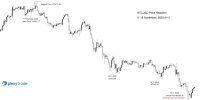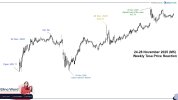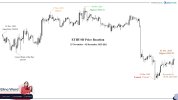Tuesday 18 November 2025
BTC/USD Market Summary: 11–18 Nov 2025
BTC/USD is the trading pair that shows how much one Bitcoin is worth in US dollars. It is the most widely followed price benchmark in the crypto market, and movements in BTC/USD often reflect the broader risk tone, investor appetite, and market sentiment. Before diving into the analysis below, this introduction helps readers understand that BTC/USD tracks Bitcoin’s value against the dollar — the foundation of most crypto price discussions.
Between November 11 and 18, 2025, Bitcoin (BTC/USD) experienced a consistent downtrend, falling from an opening price of $105,607.17 on November 11 to a weekly low of $89,260.98 by November 18. The weekly high of $107,477.39 was reached early in the period, but bullish momentum quickly faded. By November 14, BTC had dropped to $94,158.96, breaking decisively below the critical $100,000 psychological support. The decline continued into the weekend, reaching $93,342.29 on November 16, before showing brief signs of stabilization. In total, Bitcoin lost over 15% in value during the week, erasing several weeks of prior gains and reinforcing a more cautious tone across crypto markets.
This sharp pullback was driven by a combination of macroeconomic, technical, and crypto-specific factors. A broad risk-off shift in markets—triggered by fading expectations for a Federal Reserve rate cut in December—put pressure on speculative assets like Bitcoin (Reuters). From a technical standpoint, BTC fell below its 200-day moving average and formed a bearish “death cross”, a pattern often associated with extended downtrends (CoinDesk). Meanwhile, crypto-native flows also weakened, with spot Bitcoin ETF inflows flattening and long-term holders engaging in profit-taking (Reuters, CoinDesk). Sentiment deteriorated sharply, as the Crypto Fear & Greed Index dropped to 10–11, its lowest reading since the 2022 bear market. While such levels can signal eventual capitulation and rebound potential, the overall trend during this period remained firmly bearish, shaped by macro caution, technical breakdowns, and reduced institutional appetite.
Overall, this period captured a moment when Bitcoin’s momentum, sentiment, and macro backdrop aligned to the downside. It served as a clear reminder that even during broader uptrends, BTC/USD remained highly sensitive to shifts in expectations, technical levels, and investor confidence — making disciplined risk management essential.BTC/USD is the trading pair that shows how much one Bitcoin is worth in US dollars. It is the most widely followed price benchmark in the crypto market, and movements in BTC/USD often reflect the broader risk tone, investor appetite, and market sentiment. Before diving into the analysis below, this introduction helps readers understand that BTC/USD tracks Bitcoin’s value against the dollar — the foundation of most crypto price discussions.
Between November 11 and 18, 2025, Bitcoin (BTC/USD) experienced a consistent downtrend, falling from an opening price of $105,607.17 on November 11 to a weekly low of $89,260.98 by November 18. The weekly high of $107,477.39 was reached early in the period, but bullish momentum quickly faded. By November 14, BTC had dropped to $94,158.96, breaking decisively below the critical $100,000 psychological support. The decline continued into the weekend, reaching $93,342.29 on November 16, before showing brief signs of stabilization. In total, Bitcoin lost over 15% in value during the week, erasing several weeks of prior gains and reinforcing a more cautious tone across crypto markets.
This sharp pullback was driven by a combination of macroeconomic, technical, and crypto-specific factors. A broad risk-off shift in markets—triggered by fading expectations for a Federal Reserve rate cut in December—put pressure on speculative assets like Bitcoin (Reuters). From a technical standpoint, BTC fell below its 200-day moving average and formed a bearish “death cross”, a pattern often associated with extended downtrends (CoinDesk). Meanwhile, crypto-native flows also weakened, with spot Bitcoin ETF inflows flattening and long-term holders engaging in profit-taking (Reuters, CoinDesk). Sentiment deteriorated sharply, as the Crypto Fear & Greed Index dropped to 10–11, its lowest reading since the 2022 bear market. While such levels can signal eventual capitulation and rebound potential, the overall trend during this period remained firmly bearish, shaped by macro caution, technical breakdowns, and reduced institutional appetite.
Overall, this period captured a moment when Bitcoin’s momentum, sentiment, and macro backdrop aligned to the downside. It served as a clear reminder that even during broader uptrends, BTC/USD remained highly sensitive to shifts in expectations, technical levels, and investor confidence — making disciplined risk management essential.
The chart below highlights the
BTC/USD price action for
11–18 November 2025, with the latest value
last recorded at
04:00 AM GMT.














